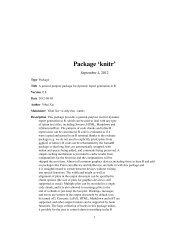Package 'openair'
Package 'openair'
Package 'openair'
You also want an ePaper? Increase the reach of your titles
YUMPU automatically turns print PDFs into web optimized ePapers that Google loves.
90 polarFreqborder.colThe colour of the boundary of each wind speed/direction bin. The default istransparent. Another useful choice sometimes is "white".key.header,key.footerAdds additional text/labels to the scale key. For example, passing options key.header = "header", keyadds addition text above and below the scale key. These arguments are passedto drawOpenKey via quickText, applying the auto.text argument, to handleformatting.key.positionkeyauto.textLocation where the scale key is to plotted. Allowed arguments currently include"top", "right", "bottom" and "left".Fine control of the scale key via drawOpenKey. See drawOpenKey for furtherdetails.Either TRUE (default) or FALSE. If TRUE titles and axis labels will automaticallytry and format pollutant names and units properly e.g. by subscripting the ‘2’ inNO2.... Other graphical parameters passed onto lattice:xyplot and cutData. Forexample, polarFreq passes the option hemisphere = "southern" on tocutData to provide southern (rather than default northern) hemisphere handlingof type = "season". Similarly, common axis and title labelling options (suchas xlab, ylab, main) are passed to xyplot via quickText to handle routineformatting.DetailspolarFreq is its default use provides details of wind speed and direction frequencies. In this respectit is similar to windRose, but considers wind direction intervals of 10 degrees and a user-specifiedwind speed interval. The frequency of wind speeds/directions formed by these ‘bins’ is representedon a colour scale.The polarFreq function is more flexible than either windRose or polarPlot. It can, for example,also consider pollutant concentrations (see examples below). Instead of the number of data pointsin each bin, the concentration can be shown. Further, a range of statistics can be used to describeeach bin - see statistic above. Plotting mean concentrations is useful for source identificationand is the same as polarPlot but without smoothing, which may be preferable for some data.Plotting with statistic = "weighted.mean" is particularly useful for understanding the relativeimportance of different source contributions. For example, high mean concentrations may be observedfor high wind speed conditions, but the weighted mean concentration may well show thatthe contribution to overall concentrations is very low.polarFreq also offers great flexibility with the scale used and the user has fine control over boththe range, interval and colour.ValueAs well as generating the plot itself, polarFreq also returns an object of class “openair”. Theobject includes three main components: call, the command used to generate the plot; data, thedata frame of summarised information used to make the plot; and plot, the plot itself. If retained,e.g. using output
















